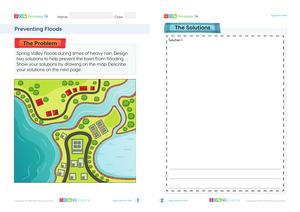Begin the lesson by discussing recent weather events in the local area, particularly focusing on any instances of heavy rain or flooding. This will help students connect the topic to real-world experiences.
Go to the LessonLearning Objectives
- Understand what a flood is and identify conditions that can cause floods.
- Recognize how floods can change the landscape and affect natural and human-made structures.
- Discuss the role of floods in the Earth's natural processes and cycles.
- Identify human activities that can contribute to the occurrence of floods.
Introduction and Hook
Introduce the concept of floods with a short narrated story or animation that illustrates how floods occur and their immediate effects on the environment.
Direct Instruction
Explain the causes of floods, emphasizing both natural factors like excessive rainfall and human-induced changes such as urban development.
Discuss the role of floods in Earth's natural processes, highlighting how they can reshape landscapes and affect both natural and human-made structures.
Guided Exploration
Watch the video on severe weather to understand how floods fit into the broader category of extreme weather events.
Engage students in a discussion about the impact of floods on communities and the environment, encouraging them to share personal experiences or stories they have heard.
Hands-On Activity
Conduct a simple experiment to demonstrate how water can overflow and spread over land. Use a tray, sand, and water to simulate a flood.
Have students work in small groups to create a model of a town and simulate a flood using water and small barriers. Discuss how different structures can affect water flow.
Independent Practice
Assign students to research a recent flood event and prepare a short presentation on its causes and effects.
Provide worksheets for students to complete individually, focusing on identifying flood-prone areas and suggesting preventive measures.
Check for Understanding
Use a quick quiz or oral questioning to assess students' understanding of the causes and effects of floods.
Encourage students to ask questions and clarify any misunderstandings about the lesson content.
Review and Reflection
Have students reflect on what they have learned about floods and how human activities can influence their occurrence.
Discuss the importance of understanding natural processes like floods in the context of environmental conservation and disaster preparedness.
Assessment and Extension
Use the 'Preventing Floods' assessment to evaluate students' ability to design solutions for flood prevention, promoting problem-solving and critical thinking.
Encourage students to extend their learning by exploring how different cultures around the world manage and adapt to flood risks.
Try the Quiz


